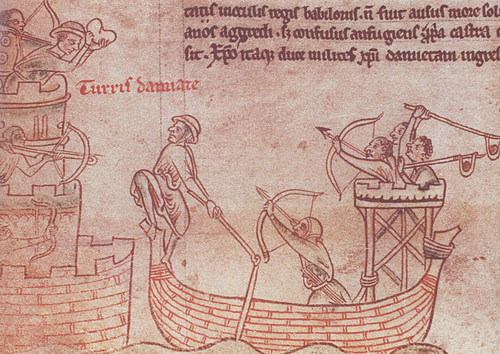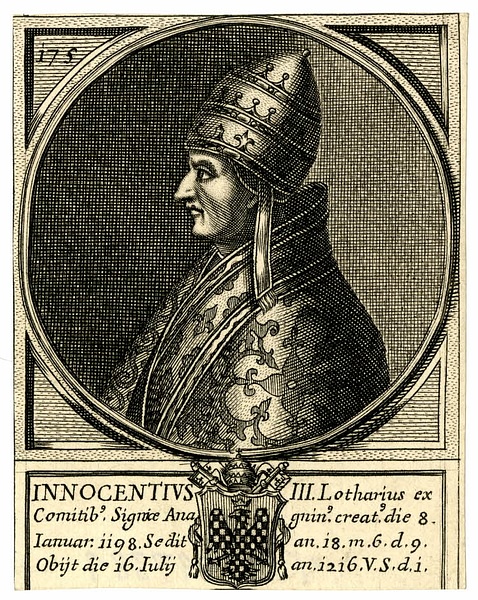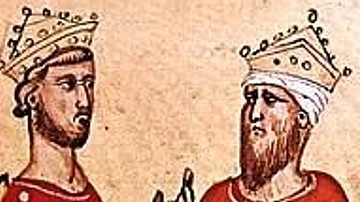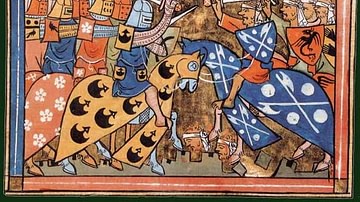
The Fifth Crusade (1217-1221 CE) was called by Pope Innocent III (r. 1198-1216 CE) with the objective, like previous crusades, of recapturing Jerusalem from Muslim control; only this time the strategy was to weaken the enemy by first attacking Muslim-held cities in North Africa and Egypt, then controlled by the Ayyubid dynasty (1174-1250 CE). The idea that Egypt would be an easier target than Jerusalem proved to be mistaken, and the campaign was not successful. The Crusader army, although eventually conquering Damietta, was beset by leadership squabbles and a lack of sufficient men, equipment, and suitable ships to deal with the local geography. Defeated on the banks of the Nile, the Crusaders returned home, once again, with very little to show for their efforts.
Previous Crusades
The previous crusade, the Fourth Crusade (1202-1204 CE), had been called by Pope Innocent III to retake Jerusalem in 1202 CE. In the event, the Crusaders instead sacked Constantinople in 1204 CE and the Byzantine territories were distributed between Venice and its allies. The objective of placing Jerusalem under Christian rule still remained an important aim of the Church and so yet another crusade, now known as the Fifth Crusade, was called for in 1215 CE, again by Pope Innocent III.
Richard I of England (r. 1189-1199 CE), during the Third Crusade (1189-1192 CE), had promoted the idea of attacking the Muslim states, not via their castles and city strongholds in the Levant but at the softer underbelly of the Muslim Ayyubid Empire: Egypt. Now that strategy would be adopted in the hope that if Egypt fell then Jerusalem, without the possibility of reinforcement and supplies, would fall too.
The Ayyubid dynasty had been founded by Saladin (r. 1174-1193 CE) and would rule Egypt until its conquest there by the Mamluks in 1250 CE. At the time of the Fifth Crusade the Sultan of Egypt, and therefore the most senior ruler in the Muslim Middle East, was Sayef al-Din al-Adil (r. 1200-1218 CE), the brother of the late Saladin. While an uneasy truce had been in existence between the Latin East states (as the Crusader states in the Middle East were known) and the Ayyubids, the latter's recent fortification of Mount Tabor in Galilee threatened Crusader-held Acre and its surrounding territory. This was the move which Innocent III used as the spark to ignite the flames of religious fervour amongst Western Europe's leadership.
Recruitment
For the first time in the run-up to the Fifth Crusade, the preaching of the Crusade, essentially its method of recruitment of volunteers, was organised by geographical areas with guidelines for provincial boards and their delegates on just how to persuade people and who to target. There were even manuals of model sermons designed to best whip up fervour and enthusiasm for the cause. Nobles and knights with the skills and means to travel and fight were to be more intensively targeted and thus such unofficial popular movements as the so-called Children's Crusade of 1212 CE, which involved peasants and children, could be avoided.
Pope Innocent III did theoretically widen the call to all males except monks but those who were not militarily skilled were strongly encouraged, perhaps even compelled, to 'redeem their vows' and give funds to the cause rather than travel in person. Those who paid but did not travel would still receive the benefit of a remission of their sins, the Pope promised. In addition, and as was by now typical papal policy, a tax (one-twentieth of income over a three-year period) was imposed on the clergy to help pay for the Crusade. The prospect of adventure, financial gain from war booty, and improving social status by acquiring new honours and titles were all additional motivators besides religious conviction.
The recruitment campaign was very successful, especially in Germany, Britain, Italy, Hungary, and the Low Countries. Pope Innocent III died on 16 July 1216 CE before he had the chance to see his Crusade get off the ground, but his successor, Pope Honorius III (r. 1216-1227 CE), had no intention of calling the campaign off. The original leader of the Crusade, and something of a coup given the absence of kings in the Fourth Crusade, was to be Frederick II, the king of Germany and future Holy Roman Emperor (r. 1220-1250 CE). Unfortunately, Frederick was unable to leave due to internal political problems within his own empire and his ongoing wrangle with the Papacy over his desire to control both German lands and Sicily, something which the Pope, fearing encirclement, wished to avoid.
Egypt & Damietta
In May 1218 CE the Crusader army landed just west of the city of Damietta in Egypt. The plan was to take the city, then with a population of around 60,000, and then march along the Nile towards Cairo, some 160 km (100 miles) distant. The army, perhaps numbering 30,000 men at its peak, consisted of the Crusader knights from Europe alongside barons from the Latin East and knights from the three major military orders: the Knights Hospitaller, Knights Templar, and Teutonic Knights. The army in the field was led by John of Brienne, king of the Kingdom of Jerusalem (r. 1210-1225 CE) but one of the problems of the Fifth Crusade would be a lack of clear leadership and decisive strategy.
The man charged with leading the Muslim army and defending Egypt was al-Kamil, son of the Sultan and his successor from August 1218 CE (until 1238 CE). Damietta, the first target of the Crusade, had three rings of formidable fortification walls. There was a moat between the first and second walls and 28 towers built into the latter. It would be a tough nut to crack, but the city, as one Crusader noted, "was the key to all Egypt" (Asbridge, 552).
The Crusader army set up camp on the west or far bank of the river outside the city. The first obstacle before the invaders even got to the city proper was to get past a huge chain hung between the city walls and a small but fortified island in the Nile Delta. This chain blocked access to the city's harbour. The Crusaders spent several months trying to attack the 21-meter (70 ft) high chain-tower. The tower was garrisoned by a force of 300 men, which could be resupplied thanks to a bridge built of boats linking the tower to Damietta. It was only when a siege tower was built on two ships lashed together that the Crusaders managed, on 24 August, to capture it and so finally lower the chain.
Taking the chain tower, though, was not the same as taking Damietta, and the city still stood, formidable, across the waters. There was also the latent threat of al-Kamil, who kept station with a large army camped on the eastern side of the Nile. Significantly, winter was now closing in, and to add to the Crusader's difficulties, the Crusader camp was flooded by the Nile during a storm on 29 November 1218 CE. The age-old problem of supplies for a besieging army also cropped up, and scurvy was rife. The inhabitants of Damietta, one can imagine, were not faring very much better.

All winter, spring, and summer of 1219 CE the two sides were at a stand-off. The Crusaders were sufficiently entrenched to make any attack on their camp highly dangerous, but they the did not have the manpower for a full-scale assault on the city or on al-Kamil's force. Indeed, some contingents of Crusaders had returned home and those that remained hoped that the balance would be tipped in their favour when Frederick II finally arrived, as long-promised, with a large army.
When news arrived that Frederick would not be coming until the next year, the Crusaders rallied themselves, boosted by the arrival of no less a figure than Francis of Assisi, who tried, unsuccessfully, to convince the Muslims that God was definitely not on their side. In the autumn of 1219 CE, it was clear that that the lower than usual levels of the Nile that year had reduced crops and now starvation was a real possibility for both sides.
A Peace Offering
In September, al-Kamil, perhaps realising the garrison of Damietta had only a very limited time left and fearing the arrival of a larger Crusader army, offered a truce with extraordinary terms. He would keep Damietta and, in return, give the Latins control of Jerusalem. Despite its religious significance to both sides, the Holy City was of very limited economic or even strategic value and had long been neglected by the Ayyubids. Parts of Palestine would also be handed over, showing that al-Kamil was more interested in his wider empire, especially the far richer lands of Egypt and Syria.
Considering that the objective of the Crusade was, after capturing Egypt, to then take Jerusalem, this offer of the Holy City was, surprisingly, rejected by some of the Crusader leadership. John of Brienne and the Teutonic Knights were keen to accept but the Knights Templar, Knights Hospitaller, Venetians and the most senior religious leader, Cardinal Pelagius, were not. The latter group were concerned that without the vital fortresses of Kerak and Montreal, which al-Kamil intended to keep, it would be difficult for the Crusaders to hold onto their gains if war with the Ayyubids followed. Most of all, the arrival of Frederick, better late than never, would almost certainly mean victory for the Westerners and then they could take what they wanted, including Egypt. So, the siege went on.
With his peace offering rejected, al-Kamil went on the offensive and attacked the Crusader camp, but his army was repulsed. In November 1219 CE the Crusaders attacked Damietta, and after breaking through a ruined tower, the city's now meagre defences were breached. The Crusaders were shocked to see the state of the enemy with the streets littered with bodies and those still alive suffering from extreme malnutrition and disease.
The March to Cairo & Defeat
Damietta was to be the only success of the campaign for the Crusaders. Taking advantage of the Crusader's indecision as to what to do next, al-Kamil, as a precaution, moved his army 40 km (25 miles) south, still hugging the Nile. Meanwhile, the Crusaders debated over who should control their new prize. The Pope's representatives wanted to keep it for Frederick while John of Brienne wanted it for himself, and to better stake his claim, he even started minting coins. In the end, a compromise was reached with gave John custody until Frederick arrived. Even more crucial to the Crusade was the debate over the next step of the campaign: march on and take Cairo or use Damietta as a bargaining chip to gain territory in Palestine, including Jerusalem. Incredibly, it took a year and a half and the arrival of a force from Germany under the command of Ludwig of Bavaria for the Crusaders to decide on the former action, and even then, in the spring of 1221 CE, they moved like snails by land and river towards their goal.
Meanwhile, al-Kamil had been able to take advantage of the enemy's indecision to fortify his camp at Mansourah and call upon the support of his allies in Syria and Mesopotamia. In July 1221 CE the Crusaders moved to attack the enemy at Mansourah. However, al-Kamil had chosen his site wisely, and it was easily defended thanks to its position at the joining of a tributary to the Nile river itself. Also, within a month, the annual rising of the Nile would occur. Although the Crusaders seemed in no particular hurry, time was on the Muslim's side, not theirs.
The canny al-Kamil, eagerly awaiting a support army and the coming floods, now choose his moment to offer a new truce deal with the enemy, perhaps in an attempt to further delay them. The Crusaders rejected the terms, though, and, after defeating a small raiding party, rashly moved to attack al-Kamil's fortified camp in August. The Muslim leader allowed them to move forward unchecked and then sank four ships behind the Crusader army to prevent any quick withdrawal. Meanwhile, the Muslim armies had arrived from the north and, taking up position to the north-east, they blocked any land retreat by the Crusaders. It was at this moment that the Nile waters started to rise. The Crusader ships began to flounder in the now treacherous waters, and a chaotic retreat ensued. When al-Kamil opened the sluice gates in the surrounding fields, the whole area was flooded waist-deep. On 28 August 1221 CE, the Crusader army surrendered and a truce was agreed upon. Al-Kamil got Damietta back and all Muslim prisoners. The Crusader army returned home unmolested. Despite all the money, effort, planning, and fervour, it was another spectacular flop of a crusade.
Aftermath
In the years after the Fifth Crusade, there was much debate and finger-pointing as to who exactly was to blame for the disaster. Nevertheless, the decision by the West to directly attack Egypt and not Jerusalem did perturb the Ayyubids as to what might happen if a larger Crusader army made a second, more decisive attempt. This threat may well have eased the negotiations of the Sixth Crusade (1228-1229 CE), led by Holy Roman Emperor Frederick II, who, finally involving himself in the Crusader movement and arriving in the Middle East in September 1228 CE, gained within a year, rather ironically, control of Jerusalem through diplomacy rather than through actual warfare.






